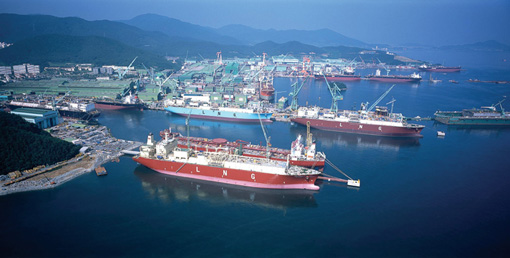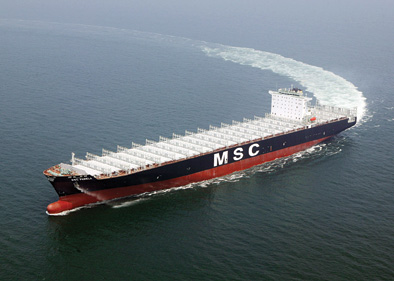SHI Recognized
for Added-Value
Vessel Construction
Registers the world's highest level in terms of the ship unit
price and a backlog of orders in the LNG carrier shipbuilding
 Samsung Heavy Industries (SHI) now has a backlog of 143 ships worth $15 billion, equivalent of more than 30 months of shipbuilding. In particular, SHI's selective landing strategy paid off last year: the company landed $7.7 billion worth of orders to build 49 ships, over 70 percent of which is comprised of such added-value vessels as LNG carriers and crude oil drill ships, and the ship unit price fetched more than a whopping $140 million, setting the highest level in the domestic shipbuilding industry.
Samsung Heavy Industries (SHI) now has a backlog of 143 ships worth $15 billion, equivalent of more than 30 months of shipbuilding. In particular, SHI's selective landing strategy paid off last year: the company landed $7.7 billion worth of orders to build 49 ships, over 70 percent of which is comprised of such added-value vessels as LNG carriers and crude oil drill ships, and the ship unit price fetched more than a whopping $140 million, setting the highest level in the domestic shipbuilding industry.
SHI now ranks first in the LNG carrier shipbuilding sector in the world. The company succeeded in receiving orders to build11 LNG carriers during 2005 and has a backlog of 33 LNG carriers, registering the highest levels in the world in terms of the amount of orders received and a backlog of orders in the sector.
 In 2003, SHI landed orders to build nine LNG carriers, taking up 56 percent of the company's total ordered ships while the company received orders to construct 19 LNG carriers, accounting for 27 percent of the total 70 ordered ships. And SHI also succeeded in biddings for 11 LNG carriers last year to dominate the global LNG shipbuilding sector.
In 2003, SHI landed orders to build nine LNG carriers, taking up 56 percent of the company's total ordered ships while the company received orders to construct 19 LNG carriers, accounting for 27 percent of the total 70 ordered ships. And SHI also succeeded in biddings for 11 LNG carriers last year to dominate the global LNG shipbuilding sector.
The reason for SHI's concentration on LNG carrier shipbuilding is that the LNG carrier, a representative added-value vessel, guarantees higher profits.
 Thanks to the company's strategy of attaching priority in landing added-value vessel orders, the portion of the LNG carrier sector to the total surged from 9 percent in 2002 to 29 percent in 2004 and 40 percent in 2005.
Thanks to the company's strategy of attaching priority in landing added-value vessel orders, the portion of the LNG carrier sector to the total surged from 9 percent in 2002 to 29 percent in 2004 and 40 percent in 2005.
The number of LNG carriers delivered to ship owners rose from three in 2004 to five in 2005, and seven and nine LNG carriers are to be delivered in 2006 and 2007, respectively. As a result, the portion of LNG carrier sales to total sales surged from 23 percent in 2004 to 40 percent in 2005,
 and the figure is projected to grow to 50 percent next year.
and the figure is projected to grow to 50 percent next year.
In particular, SHI developed the next-generation "LNG carrier with electric propulsion system"in the world in 2001, boasting of excellent navigation performance and fuel efficiency. The company landed orders to build 14 electric LNG carriers, taking up 48 percent of the total 23 LNG carriers, up for grabs in the global market.
 SHI plans to fortify its position as a company specializing in construction of special ship by raising the LNG carrier shipbuilding from the current seven ships to 14 ships through freight warehouse equipment expansion and augmentation of welding manpower. Rather than oil tankers and containerships ¡ª with general technologies and competition heating up among Japanese and Chinese and other shipbuilding companies ¡ª SHI is focusing on the R&D activities of such vessels as icebreaking oil tankers, LNG carriers, oil drillships, VLCCs and cruise ships to continue to increase the percentage of added-value vessels standing at a range of 70 percent.
SHI plans to fortify its position as a company specializing in construction of special ship by raising the LNG carrier shipbuilding from the current seven ships to 14 ships through freight warehouse equipment expansion and augmentation of welding manpower. Rather than oil tankers and containerships ¡ª with general technologies and competition heating up among Japanese and Chinese and other shipbuilding companies ¡ª SHI is focusing on the R&D activities of such vessels as icebreaking oil tankers, LNG carriers, oil drillships, VLCCs and cruise ships to continue to increase the percentage of added-value vessels standing at a range of 70 percent.
SHI has been credited with having successfully reduced losses from foreign exchange fluctuations.
The company, which raked in a record high of $7.7 worth of orders in 2005 following $6.4 billion worth of orders in 2004, had singed a forward exchange deal of each order received to hedge 100 percent against a plunge of the dollar as part of its efforts to block losses arising from foreign exchange fluctuations.
 Thanks to these efforts, SHI has managed to avoid a danger of sale losses worth about 500 billion won estimated at the current foreign exchange rates against a backlog of orders. Meanwhile, SHI plans to reduce costs through improved productivity and adopt a strategy designed to focus on added-value vessel orders, given the fact that the continuous appreciation of the won inevitably could reduce profitability of the future orders.
Thanks to these efforts, SHI has managed to avoid a danger of sale losses worth about 500 billion won estimated at the current foreign exchange rates against a backlog of orders. Meanwhile, SHI plans to reduce costs through improved productivity and adopt a strategy designed to focus on added-value vessel orders, given the fact that the continuous appreciation of the won inevitably could reduce profitability of the future orders.
SHI's FLOATING DOCK ¡ª The company has been praised for enhancing productivity by devising an idea of "floating dock shipbuilding"using offshore cranes for the first time in the world.
Despite diverse methods of opposition from its rival Japan, the government and domestic competitions, SHI has established itself as a world-class shipbuilding company by constructing a 640 meter-long No. Three Dock.
After strenuous study, SHI began to graft the"Mega Block"method using a 3,000 tons offshore crane and a floating dock into shipbuilding in 2002 for the first time in the world.
The Mega Block method requires only 11 blocks instead of about 80 blocks necessary for the construction of a 100,000 ton-class oil tanker, shortening construction period. By supplying products that have finished decoration and painting on the ground, the method could reduce the work process on dock by 40 percent or the dock work period from 2.5 months to 1.5 months.
Thanks to the Mega Block method and floating dock, SHI has secured the world's top position in terms of dock utilization rate and productivity by unit area. nw
SHI President-CEO Kim Jing-wan
(Closewise) LNG carriers, now under construction at SHI's Geoje Shipyard; a 35,000-ton, high-speed passenger ship, built by SHI; a drillship (SHI takes the highest share in the drillship shipbuilding market); the biggest 9,200TEU-class full containership and the 640 meter-long No. Three Dock, the longest one of the shipyard.
3Fl, 292-47, Shindang 6-dong, Chung-gu, Seoul, Korea 100-456
Tel : 82-2-2235-6114 / Fax : 82-2-2235-0799